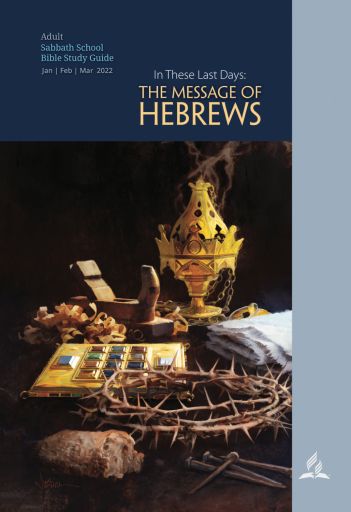
In These Last Days: The Message of Hebrews
It was at church when he first saw her. He was running an errand, absorbed in his thoughts, when the sight hit him. The painting was a little less than two meters high and three meters wide, but the girl portrayed in it exerted a strange captivating force over the young man. Why could he not take his eyes off of her? What was it? After some reflection, he realized that it was her eyes. The painting portrayed only her face, and she was looking at something intently. But what, and why was she so absorbed in it? For a long time afterward, he couldn’t get the painting out of his head.
Several years later, the painter, Arnold Jiménez, revealed some of its secrets to him. The painting was made to attract viewers to her eyes, but the real secret was in her pupils. If you looked closely, you would find out that they reflected what she was looking at. Her eyes were fixed on Jesus on the cross.
The portrait of Jesus in the Letter to the Hebrews can exert a similar captivating force upon us. Jesus is described, first of all, as the ruler of the universe enthroned at God’s right hand. Innumerable angels celebrate Him, worship Him, and serve Him (Heb. 1:5–14, Heb. 12:22–24). He has won the right to rule because He has ensured the destruction of the devil (Heb. 2:14–16) through His own death. Jesus also is the exalted High Priest. Sinless and perfectly holy, He lives forever to minister in our behalf in the heavenly sanctuary (Heb. 7:26–8:5). He has won the right to do so because He offered Himself as a perfect, once-for-all sacrifice, effective for everyone and forever (Heb. 10:1–14). Jesus also has mediated a new covenant between God and His people that will stand forever (Heb. 8:6–13).
What captivates readers about the portrait of Jesus, however, is not simply what Jesus has done but who He is. He was born from a woman, as we were, and He has been tempted and ridiculed, as we have been. Yet, still, He sits at the center of power in the universe. When we gaze at the heavenly scene, with its diverse and fantastic celestial beings, our eyes are attracted to the One in the center of it all, who, amazingly enough, looks like us because He has become one of us. Jesus, our Brother, is there, in heaven, representing us, despite the shame of our sin and fallenness.
In the person of Jesus, three dimensions of the story of Redemption intersect. The first is the local, personal dimension. For readers tired of the reproaches and hardships of Christian life (Heb. 10:32–34), Jesus is the author and perfecter of faith. They need to look to Him, who also suffered at the hands of sinners (Heb. 10:32–34, Heb. 12:1–4). The second is the corporate, national dimension. For the people of God, who are traveling toward God’s Promised Land, Jesus is the new Joshua. They need to follow His lead (Hebrews 3, Hebrews 4, Hebrews 11, Hebrews 12). The third is the universal dimension. Jesus is the new Adam, the Son of man, in whom God’s purposes for humanity are fulfilled (Heb. 2:5–10, Heb. 12:22–28).
The portrait of Jesus, who captures the breadth and length and height and depth of God’s love for us, is our subject this quarter. And just as the image of Jesus in the eyes of the girl in the painting captured the young man’s gaze, may the image of Jesus as portrayed in Hebrews capture not just our gaze but our love and admiration for, yes, Jesus, our Brother in heaven.
Félix H. Cortez is associate professor of New Testament literature at Andrews University. He is married to Alma Gloria Alvarez and has two children, Hadid, a pastor in New Jersey, and Alma, an archaeology major at Andrews University.
© 2021 General Conference of Seventh-day Adventists®. All rights reserved. No part of the Adult Sabbath School Bible Study Guide may be edited, altered, modified, adapted, translated, reproduced, or published by any person or entity without prior written authorization from the General Conference of Seventh-day Adventists®. The division offices of the General Conference of Seventh-day Adventists® are authorized to arrange for translation of the Adult Sabbath School Bible Study Guide, under specific guidelines. Copyright of such translations and their publication shall remain with the General Conference. “Seventh-day Adventist,” “Adventist,” and the flame logo are registered trademarks of the General Conference of Seventh-day Adventists® and may not be used without prior authorization from the General Conference.
For questions and concerns about the Adult Bible Study Guide, please contact the Editor of the Bible Study Guide, Clifford R. Goldstein